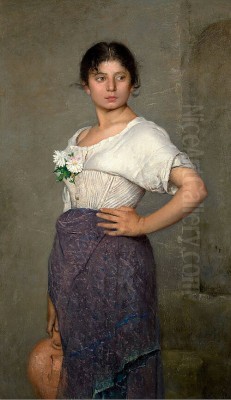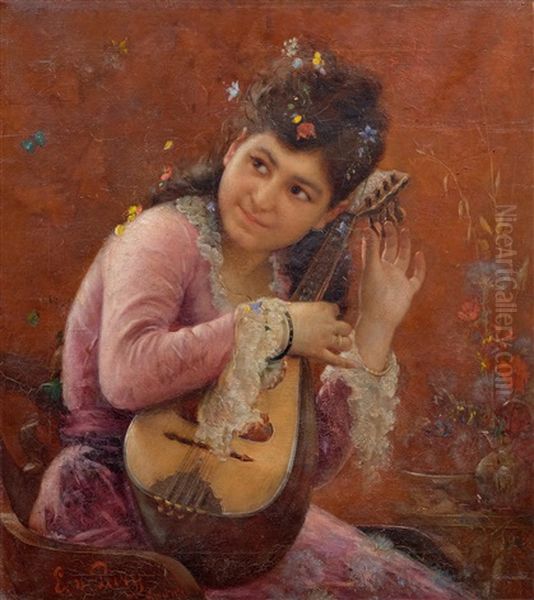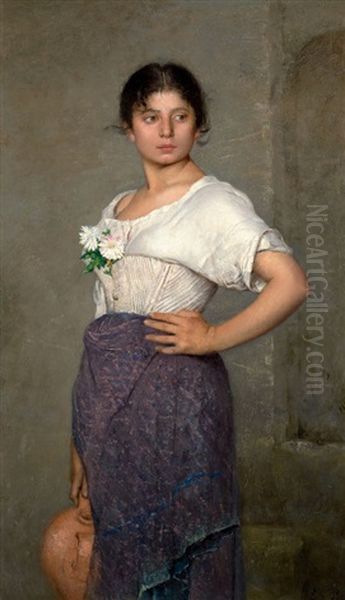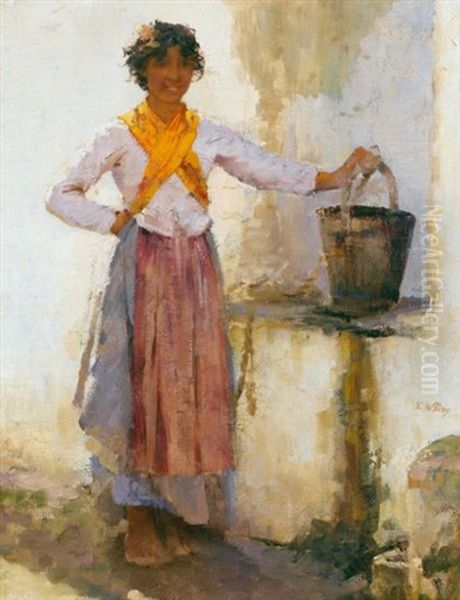
Edmond Jean de Pury stands as a notable figure in Swiss art history, a painter whose career unfolded during a vibrant period of artistic transformation in Europe. Active primarily in the latter half of the 19th century and the dawn of the 20th, de Pury carved a niche for himself with his sensitive oil paintings, particularly those capturing the essence of Italian peasant life and evocative female portraiture. His journey through the art world saw him engage with prominent artistic circles, absorb diverse influences, and leave behind a body of work that continues to be appreciated for its technical skill and gentle humanism.
Early Life and Artistic Inclinations
Born on March 6, 1845, in the Swiss canton of Neuchâtel, Edmond Jean de Pury hailed from a family with a noteworthy, albeit somewhat indirect, connection to transatlantic ventures and significant local philanthropy. His family name was associated with Jean Pierre Pury, who had earlier attempted to establish Purrysburg, a Swiss colony in South Carolina. While this colonial endeavor did not achieve its intended success, a relative, David de Pury, one of Jean Pierre's sons, who did not join the colonial venture and was reportedly sent to an orphanage, later amassed a considerable fortune in Lisbon. David de Pury's subsequent immense bequest to his hometown of Neuchâtel profoundly impacted its development, funding a public library, the town hall, and significant urban improvements, leading to a monument being erected in his honor in 1855.
While Edmond Jean de Pury's direct involvement in these ancestral narratives is not prominent, this background of ambition and civic contribution formed part of his heritage. It was, however, the world of art that would define Edmond's path. Growing up in an era where artistic pursuits were gaining increasing professional stature, young de Pury developed a passion that would lead him away from more conventional careers and towards the studios and salons of Europe. Another profound interest that would accompany him throughout his life and travels was a deep love for music, an art form whose rhythms and harmonies perhaps subtly infused his visual creations.
Parisian Training: The Crucible of Atelier Gleyre

The allure of Paris, the undisputed capital of the 19th-century art world, was irresistible for any aspiring artist. Edmond Jean de Pury made his way to this bustling metropolis to hone his skills. He enrolled in the prestigious atelier of Marc Gabriel Charles Gleyre (1808-1874), a Swiss-born painter who had established himself as a highly respected teacher in Paris. Gleyre's studio was a magnet for young talent from across Europe and America, known for its relatively liberal teaching methods compared to the stricter École des Beaux-Arts, though still rooted in academic tradition.
Gleyre himself was an artist who navigated between Neoclassicism and Romanticism, often infusing his historical and mythological scenes with a poetic, sometimes melancholic, sensibility. His students were a diverse group, many of whom would go on to achieve international fame and redefine artistic movements. Among de Pury's contemporaries in Gleyre's studio, or active in Paris at the time and likely known to him, were figures who would become pillars of Impressionism, such as Claude Monet, Auguste Renoir, Alfred Sisley, and Frédéric Bazille. Other notable artists associated with Gleyre's teaching include the American James Abbott McNeill Whistler and the English painter Edward Poynter. The environment was undoubtedly stimulating, a place of intense learning, camaraderie, and the germination of new artistic ideas. He also would have been aware of the towering figures of French academic art like Jean-Léon Gérôme, himself a product of a similar academic system and a fellow student under Gleyre, and Jean-Louis Hamon. The influence of Realists like Jean-François Millet, with his dignified portrayals of peasant life, also permeated the artistic atmosphere.
This period of study under Gleyre provided de Pury with a strong foundation in drawing, composition, and the techniques of oil painting. While Gleyre's direct stylistic impact on all his students varied, the discipline and exposure gained in such an environment were invaluable. De Pury absorbed the academic emphasis on skilled draughtsmanship and carefully constructed compositions, traits that would remain evident in his work even as he developed his individual style.
The Italian Sojourn: Light, Life, and Landscape
A pivotal chapter in Edmond Jean de Pury's artistic development was his time spent in Italy. Like many artists before and during his time, from Jean-Auguste-Dominique Ingres to Camille Corot, de Pury was drawn to the Italian peninsula, renowned for its rich artistic heritage, stunning landscapes, and the vibrant character of its people. He immersed himself in the study of Italian art and life, spending significant periods in Rome, the picturesque island of Capri, and the unique city of Venice.

It was in Italy that de Pury found one of his most enduring themes: the depiction of Italian peasants. These were not romanticized or overly sentimentalized portrayals, but rather observations imbued with a quiet dignity and an appreciation for the textures of everyday existence. His canvases began to fill with scenes of women at wells, families in rustic settings, and individuals engaged in daily chores or moments of repose. The Mediterranean light, with its clarity and warmth, profoundly influenced his palette, leading to richer colors and a more nuanced handling of light and shadow. This focus on genre scenes, depicting ordinary people in their daily lives, was a popular current in 19th-century art, offering an alternative to grand historical or mythological subjects. Artists like Léon Bonnat also found inspiration in Italian folk life.
His time in Capri, in particular, seems to have been fruitful. The island, with its dramatic cliffs, azure waters, and distinctive local culture, provided ample inspiration. Works from this period often feature young women in traditional attire, their figures rendered with a combination of academic solidity and an emerging sensitivity to atmospheric effects. Venice, with its unique interplay of water, light, and architecture, also left its mark, encouraging a more fluid handling of paint and an appreciation for reflective surfaces.
Artistic Style: A Synthesis of Tradition and Sensitivity
Edmond Jean de Pury's artistic style can be characterized as a refined blend of academic realism with a subtle infusion of the sensibilities that were contemporaneously shaping Impressionism. He remained committed to representational accuracy and a high degree of finish, particularly in his figures, which were often meticulously drawn and modeled. His brushwork was generally controlled and precise, allowing for a detailed rendering of textures, fabrics, and facial features.
However, de Pury was not immune to the growing interest in capturing the fleeting effects of light and atmosphere. While not an Impressionist in the revolutionary sense of Monet or Renoir, his work often displays a heightened awareness of color and light. He skillfully used chiaroscuro to give volume to his figures and to create mood, but also explored more luminous palettes, especially in his Italian scenes. There's a softness and a gentle radiance in many of his paintings, particularly in the depiction of female skin, which seems to glow against darker backgrounds or within sun-dappled environments.
His thematic concerns revolved largely around the human figure. Portraits, often of women, form a significant part of his oeuvre. These are characterized by a psychological sensitivity, capturing not just a likeness but also a sense of the sitter's inner life. His genre scenes, especially those from Italy, celebrate the simple beauty of ordinary life, finding grace and dignity in the everyday. There is a lyrical quality to many of his compositions, a quiet poetry that invites contemplation.
Representative Works and Recognition

Several works stand out in Edmond Jean de Pury's oeuvre, showcasing his characteristic style and thematic preoccupations. Jeune femme et mandoline, Capri (Young Woman and Mandolin, Capri), dated 1878, is a prime example of his Italian period. It likely depicts a young Caprese woman, her features rendered with care, holding a mandolin, an instrument often associated with Italian folk music. The painting would have combined skilled portraiture with an element of picturesque local color.
Another significant piece is La Cantilène (The Ballad or The Song), painted around 1900. The title itself suggests a connection to music, perhaps depicting a figure singing or listening to a song, and would embody the lyrical quality often found in his work. The painting At the Well is also frequently cited as a representative work. This theme, a classic in genre painting, allowed artists to depict figures in a natural, everyday setting, often focusing on the grace of female forms and the social interactions around a communal water source. De Pury’s rendition is noted for the unique radiance of the female figure, set off against the background, showcasing his mastery of light.
De Pury's talents did not go unnoticed. He exhibited his works in Paris, a crucial arena for artistic recognition. A notable achievement was winning an award at the Exposition Universelle (World's Fair) in Paris in 1889 for a portrait of the composer Richard Wagner. This accolade underscores his skill in portraiture and his connection to the cultural currents of his time, including the widespread fascination with Wagner's music. His paintings were also exhibited in various other European venues, including Venice, a testament to his growing reputation, and at the Château de Chambord. Naturally, his works were also shown in his native Switzerland, in cities like Zurich and Winterthur, contributing to the Swiss art scene alongside contemporaries such as Auguste Veillon and François Bocion, who were also active and exhibiting during this period.
The Enduring Presence of Music
Throughout his life, Edmond Jean de Pury maintained a profound passion for music. While the specifics of how this passion directly manifested in his daily life or artistic practice are not always minutely detailed in historical records, it is noted as a constant companion during his life and travels. It is plausible to imagine that music provided inspiration, solace, or a complementary aesthetic experience that resonated with his visual artistry.
The titles of some of his works, like La Cantilène, directly allude to music. The depiction of figures with musical instruments, such as in Jeune femme et mandoline, Capri, further solidifies this connection. Beyond literal representations, one might speculate that his sense of rhythm in composition, the harmony of colors, or the emotive qualities he sought to convey in his figures could have been subtly influenced by his musical sensibilities. In an era where the sister arts were often discussed in relation to one another, with concepts like "tone poems" in music and "symphonies" in color (as explored by artists like Whistler), de Pury's dual passion would have found a receptive cultural environment.
Later Years and Legacy
Edmond Jean de Pury continued to paint into the early 20th century, remaining largely faithful to the artistic principles he had cultivated throughout his career. He passed away in November 1911 (sources vary, with some citing November 7th or 21st) in Lausanne, Switzerland, leaving behind a legacy as a skilled and sensitive painter.
In the broader sweep of art history, de Pury might not be categorized with the avant-garde revolutionaries who dramatically altered the course of Western art. He was not a radical innovator in the vein of the Impressionists he studied alongside, nor did he push into the Post-Impressionist explorations of artists like Paul Cézanne or Vincent van Gogh. Instead, his contribution lies in his mastery within a more traditional framework, infused with a personal sensitivity and a keen observational skill. He represents a significant strand of late 19th-century European art that valued craftsmanship, beauty, and the depiction of human experience with empathy and grace.
His works are held in various public and private collections and continue to appear at art auctions, where they are appreciated for their aesthetic appeal and technical accomplishment. For art historians and enthusiasts of Swiss art, and of 19th-century European painting more broadly, Edmond Jean de Pury remains an artist worthy of study and admiration. He successfully navigated the rich artistic currents of his time, drawing from his academic training, his experiences in Italy, and his own innate talents to create a body of work that speaks with a quiet but distinct voice.
Conclusion: A Harmonious Vision
Edmond Jean de Pury's artistic journey reflects a dedicated pursuit of beauty and expression through the medium of oil paint. From his formative years in Neuchâtel and his rigorous training in Paris under Marc Gabriel Charles Gleyre, to his inspiring sojourns in Italy, he consistently sought to capture the nuances of human character and the gentle poetry of everyday life. His paintings, whether portraits radiating an inner light or genre scenes depicting Italian peasants with dignity, are testaments to his technical proficiency and his empathetic vision.
While the art world around him was often in a state of ferment, with movements like Impressionism and Post-Impressionism challenging established norms, de Pury charted a course that honored tradition while embracing a personal sensitivity to light, color, and emotion. His connection to music, his award-winning portraiture, and his evocative depictions of Italian life all contribute to a portrait of an artist deeply engaged with the cultural and aesthetic currents of his era. Edmond Jean de Pury's legacy is that of a refined and accomplished painter whose works continue to offer viewers a window into a world rendered with skill, grace, and a profound appreciation for the human spirit.